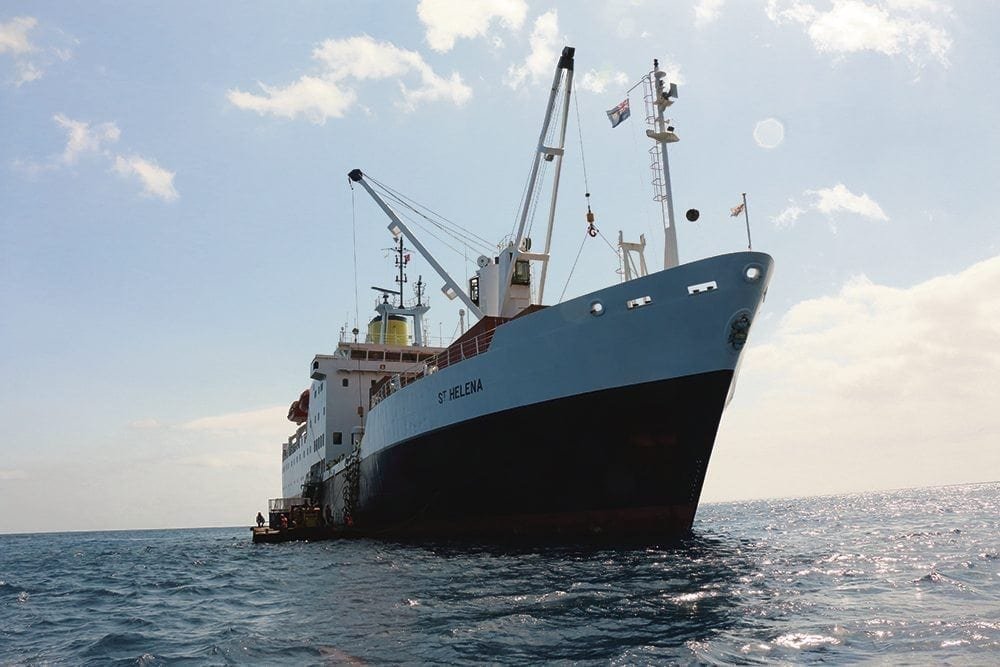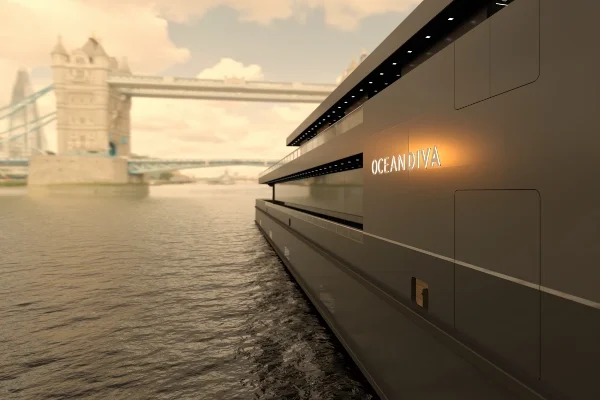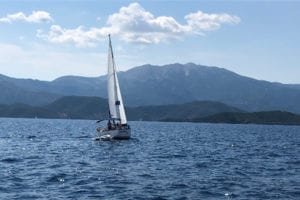One-third of the way across the South Atlantic from Africa to America, in one of the emptiest oceans in the world, lies an extraordinary sliver of Britain. And in the middle of the sliver is a micro slice of France.
Named after the Saint’s day on which it was discovered – five centuries past – by astonished Portuguese sailors, St Helena is one of the world’s most remote inhabited islands. But it doesn’t always feel that way. Walk up Main Street in Jamestown, the ‘capital’, and you’ll find much that’s familiar – if a little out of time.
On the one hand you can imagine yourself in a Devon market town from the 1950s: the pace of life’s easy, with people gossiping on benches outside their whitewashed houses. On the other hand young men sport shades at the wheel of their 4x4s, flush from a spell of work on the military bases on Ascension Island or the Falklands, bass-heavy music hammering out of their stereos.
The middle of nowhere
 First, though, you have to get there. In 2016 St Helena’s first airport will open – and the island will be tugged sharply into the 21st century. For now, unless you own a yacht, you’ll spend five days and nights sailing out from Cape Town on the ‘Royal Mail Ship St Helena’.
First, though, you have to get there. In 2016 St Helena’s first airport will open – and the island will be tugged sharply into the 21st century. For now, unless you own a yacht, you’ll spend five days and nights sailing out from Cape Town on the ‘Royal Mail Ship St Helena’.
Like the island, it’s one of a kind. Virtually everything that travels to or from the place does so on the ‘RMS’: people (living and dead), fridge freezers, cars, food… It’s the island’s sole lifeline – and the last in a line of ships built specially for the task.
The journey is a combination of the banal and the wild, with Bovril for elevenses, quiz nights and deck cricket – all with the wide, wild immensity of the blue sea all around, unblemished from horizon to horizon. The RMS strikes out far from the nearest shipping lanes, settlements or even flight paths. A hundred, a thousand, a million years ago, the outlook beyond the rail would have been the same. This really is the middle of nowhere.
Next year the RMS will be pensioned off and the first tourists will be jetting in from Johannesburg to a spanking new airport which, the government hopes, will catalyse economic development. It’s a big ask.
Napoleon and the stars
 St Helena is a dependency in more than one sense of the word. Once a vital staging post on the journey east – before the Suez Canal stole its rite of passage – it’s now largely a subsidy economy. Many of the ‘Saints’, as the islanders refer to themselves, work for the government, or in government-owned businesses. Boosting tourism is key to prospects of a more independent, sustainable economy. And there is much for tourists to see.
St Helena is a dependency in more than one sense of the word. Once a vital staging post on the journey east – before the Suez Canal stole its rite of passage – it’s now largely a subsidy economy. Many of the ‘Saints’, as the islanders refer to themselves, work for the government, or in government-owned businesses. Boosting tourism is key to prospects of a more independent, sustainable economy. And there is much for tourists to see.
Napoleon’s six years here – between Waterloo and his death in 1821 – already act as a tourist draw. The few acres comprising his house and tomb were given to France when Britain sought favour from Paris in the mid-19th century, and there is even a French consul general in residence to keep watch on this tiniest corner of La République.
The isolation that made St Helena suitable for tucking away an ex-Emperor attracts another sub species of tourist: stargazers. Far from any source of serious light pollution, the island has a quite astonishingly clear night sky. Stand in a valley sheltered even from the scattering of street lamps, and the stars seem so close you could almost pluck them by hand. Small wonder plans are afoot for it to become an official International Dark Sky Park.
As for the landscape…
For a small island, the countryside is impressively varied. Starting from the coasts, bare, wave lapped cliffs rise to arid grassland and, in some cases, strips of rocky desert. The odd waft of sand serves as a reminder of a primeval sea floor, when the ocean was hundreds of metres higher than it is today.
This gives way to pasture – much of it bare, overgrazed and, in places, scarred with the red-earth gashes of gully erosion. There are swathes of quite English-looking countryside: hills and valleys intercut by winding, flower- banked lanes, a mix of pasture, plantation forest – pines, eucalypts – and patches of vegetable gardens.
Clinging to the ridge line of Diana’s Peak and Mount Actaeon is the cloud forest – a tangle of tree ferns, brackeny things and weird- looking, weirdly named spindly shrubs – ‘he cabbage’ and ‘she cabbage’.
Below the cloud forest, ever threatening to overwhelm it, is a vast blanket of flax – the pervasive relic of a Victorian attempt to inject a sense of industry into island life. Like most enterprise on St Helena this was a government- backed initiative; it provided the raw material for mail bags and a (barely) living wage for the islanders. The mills shut down in the ‘60s, but the flax remains, swallowing the ground, the big daddy of all the island’s (many) invasive species. From a distance it looks like a gorgeous sea of green, but beneath its photogenic surface it quietly smothered the native flora.
 Play Video about This Rock Might Just Save The World
Play Video about This Rock Might Just Save The World Play Video about Play 2 hours of rock
Play Video about Play 2 hours of rock Play Video about Play 2 hours of brook
Play Video about Play 2 hours of brook Play Video about Play 2 hours of sheep
Play Video about Play 2 hours of sheep


















 First, though, you have to get there. In 2016 St Helena’s first airport will open – and the island will be tugged sharply into the 21st century. For now, unless you own a yacht, you’ll spend five days and nights sailing out from Cape Town on the ‘Royal Mail Ship St Helena’.
First, though, you have to get there. In 2016 St Helena’s first airport will open – and the island will be tugged sharply into the 21st century. For now, unless you own a yacht, you’ll spend five days and nights sailing out from Cape Town on the ‘Royal Mail Ship St Helena’.  St Helena is a dependency in more than one sense of the word. Once a vital staging post on the journey east – before the Suez Canal stole its rite of passage – it’s now largely a subsidy economy. Many of the ‘Saints’, as the islanders refer to themselves, work for the government, or in government-owned businesses. Boosting tourism is key to prospects of a more independent, sustainable economy. And there is much for tourists to see.
St Helena is a dependency in more than one sense of the word. Once a vital staging post on the journey east – before the Suez Canal stole its rite of passage – it’s now largely a subsidy economy. Many of the ‘Saints’, as the islanders refer to themselves, work for the government, or in government-owned businesses. Boosting tourism is key to prospects of a more independent, sustainable economy. And there is much for tourists to see.  Passengers on the RMS are issued with leaflets on ‘biosecurity’ in an effort to keep the endemics clinging on. It’s an uphill struggle. Old prints show that, by the time the landscape was first recorded, it was already stripped bare of most of its original vegetation, the tree ferns and hardwoods that had once cloaked the land. The lethal combination of man and goat had done its work.
Passengers on the RMS are issued with leaflets on ‘biosecurity’ in an effort to keep the endemics clinging on. It’s an uphill struggle. Old prints show that, by the time the landscape was first recorded, it was already stripped bare of most of its original vegetation, the tree ferns and hardwoods that had once cloaked the land. The lethal combination of man and goat had done its work.  Conservationists remain optimistic that much can still be salvaged. With the support of the Department for International Development, the airport developers are restoring wetlands and helping with the creation of a ‘Millennium Forest’ to replace the Great Wood. Careful flax clearance is uncovering native species which, with impressive stubbornness, spring back to life. After years of retreat, the cloud forest is slowly gaining ground once again.
Conservationists remain optimistic that much can still be salvaged. With the support of the Department for International Development, the airport developers are restoring wetlands and helping with the creation of a ‘Millennium Forest’ to replace the Great Wood. Careful flax clearance is uncovering native species which, with impressive stubbornness, spring back to life. After years of retreat, the cloud forest is slowly gaining ground once again. 






















